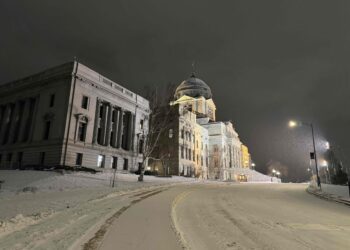By Tim Treuer Writers on the Range
On May 9, protected by neoprene, I bobbed around in a flooded canyon in Utah’s Lake Powell. The reservoir had fallen below 35 percent full, which gave me the unique opportunity to free-dive through an underwater bridge that was now suddenly within reach.
I eyed the 100 feet of sheer sandstone rising out of the water. For much of the past half-century, boats that entered upper Fiftymile Canyon in Glen Canyon National Recreation Area could blithely float over Gregory Natural Bridge with about 40 feet of clearance.
Not anymore. Two decades of drought had diminished the lake, and motorized river traffic could no longer float overtop.
Now, however, a new passageway to Fiftymile’s inner sanctum was possible. That gave me a chance to become (possibly) the first person to pass under Gregory Natural Bridge since the archway was drowned 52 years ago.
Doing so would require swimming underwater while holding my breath, something I’d practiced over a decade and a half of visiting coral reefs. I’m far from a professional free diver, but I have been known to spend a minute or two communing with croaking toadfish 50 feet beneath the waves.
I filled my lungs one last time and plunged down, scissor-kicking my way into the bracing, turbid water.
I’d spent the previous week with 11 other Alaskans in southeastern Utah, negotiating the rapids of the Escalante River, an underappreciated gem that used to join the Colorado River but now feeds into Lake Powell. The Escalante has traditionally been considered navigable only during its spring flood. But word had trickled out that pack-rafts and patience could get you down the last 40 miles of it before it reached Lake Powell, even during low flows.
Upriver in the town of Escalante, a water gauge gave a reading of just half a cubic foot per second for much of our journey, which began at Fence Canyon, 40 miles down the river. Only the cumulative output of spring-fed side canyons kept us moving.
When we arrived at Lake Powell’s “full pool line,” where the reservoir used to start when Glen Canyon Dam was at capacity, we were in for a shock. It would have been impossible to guess that water once covered the banks; now, cottonwoods three stories tall bordered the river.
It would take us another day and a half of increasingly arduous travel to finally enter Lake Powell.
As the shoreline vegetation shrank, then disappeared, we gave up trying to float and began walking our boats. The braided river channel was choked with sediment that broke off from the banks in basketball-sized chunks. A rock pinnacle called Explorer Island was ringed with cracked mud studded with dry buoys.
I’ve worked as a field ecologist for almost as long as the Western Rockies have been in a state of drought, but I’ve never seen a place so clearly in the throes of change. In 36 hours, we’d rewound the tape on 20 years of ecological succession — from riparian forest back to mud.
We were ready to quit sloshing through the Escalante River when we finally reached the depleted reservoir and our rented houseboat. Then it took us less than an hour to reach our goal, the place where Gregory Natural Bridge lurked beneath us. There, time compressed as I dropped underwater and passed through a shimmering boundary between the sun-warmed surface layer and the colder depths. Only then did the top of the archway come into view.
As I passed under it at about 15 feet, there was more overhanging sandstone. Low visibility obscured what was ahead, but I decided to trust my lungs and finned forward, following the gradual rise of the rock above me.
A diffuse glow became refracted light and then sunshine as I splashed back into the day. I was just 50 feet upstream, but once under the bridge and out the other side, I was in a world removed from where I had taken my last breath.
It was quiet, with no sound of boats or people. Around me rose a red-rock panorama that had been hidden away for years. It was glorious.
True, it might be a tragedy for flat-water recreationists and businesses if climate change and over-allocation of water rights in the West doom Glen Canyon Dam, letting loose the Colorado River.
But I can attest there would be marvels for visitors, and what a boon for nature that would be.
Tim Treuer is a contributor to Writers on the Range, writersontherange.org, a nonprofit dedicated to spurring lively conversation about the West. He lives in Alaska and is a writer and ecologist.












